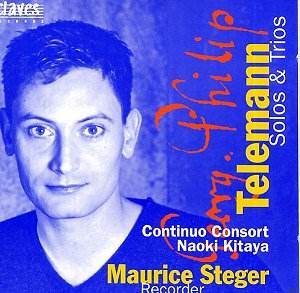|
Telemann wrote a bewildering number of works in a wide
variety of forms. His ability to write attractive music in the fashionable
styles of the day ensured that he remained popular throughout his lifetime.
Unfortunately that popularity does not seem to have carried through to
today and recordings of his works rather lag behind those of his contemporaries.
So this disc, which brings together a number of his works for Recorder
and Flute played by the young Swiss virtuoso Maurice Steger, is very welcome.
Telemann's Recorder music is in particular short supply in the catalogue
so this disc is doubly welcome.
The music on the disc is in a variety of styles. The
Sonatas are in the very traditional 4-movement sonata da chiesa form.
Whereas the Fantasias for solo flute were the epitome of modernism at
the time. During the 18th century the recorder became increasingly
popular as a chamber music instrument amongst amateurs. So much of Telemann's
music for recorder would have been written for this market. Most of the
movements are quite short and the slower movements make good use of Telemann's
enviable melodic gifts.
Maurice Steger has a fine technique: his passage work
is executed in subtle style and his tuning is excellent. Though I did
wonder whether he could not have exercised a little fantasy in the area
of ornaments and appoggiaturas. The faster movements are quite short and
are apt to end rather suddenly. Telemann does play with unexpected endings,
but too often I found myself being brought up short by a too sudden ending.
Surely it would have been more rewarding if Steger and his partners could
have shaped these movements a little more.
The recording is an exceptionally close one and this
leads to a number of faults which would not be so apparent in the concert
hall, or on a recording that allowed the performer more space to breathe.
A particular problem is that the close miking makes Steger's breathing
extremely audible. Performance involves work, it is unreasonable to expect
a recording to sound as if it was being played by an automaton. But the
closeness of this recording means that Steger's breathing can become disturbing.
In passage work, the notes are given to little time to register, sometimes
reducing the more complex passages to a breathy percussive effect which
seems vastly unfair to Steger. I am sure that if you heard him live the
effect would be far more musical.
The Sonatinas are all 4 movement works with the traditional
Fast, Slow, Fast Slow alternation. The Fantasias are remarkable, two movement
works in which Telemann manages to suggest a remarkable variety of forms
and textures with just the solo Flute line. Steger shows an admirably
grasp of technique and form in these. But Telemann was experimenting as
well in the more traditional works. The opening movement of the three
movement Sonata has a striking tempo change (slow to fast). The third
movement of the Trio Sonata in B flat is a charmingly graceful Siciliana.
This Trio Sonata uses an obbligato harpsichord in addition to the basso
continuo, showing Telemann undertaking the sort of experiment which would
gradually lead to the classical duo Sonata. The Trio Sonatas vary between
three movement and four movements as Telemann tries out newer structural
techniques.
In the Trio Sonatas Steger is joined by variety of colleagues
from the continuo group. All the musicians are admirable and they play
the Trio Sonatas with the sort of relaxed music making that is ideal for
this sort of chamber music written for private performance. The musicians
form a homogenous group in which Steger is, rightly, the first amongst
equals rather than a dominant soloist. Though, in the Trio Sonata in B-Flat,
I wished that the obbligato harpsichord had been a little louder. Here,
there was a danger of Steger dominating the proceedings when he and Naoki
Kitaya (the obbligato harpsichord player) should have been equals.
The handsome booklet is admirable when dealing with the
musicians (and their instruments) and there is an excellent background
article. But nowhere do they print the TWV numbers of the works. With
a catalogue as large as Telemannís it is always useful to have the catalogue
numbers of the works for reference.
The musicians have put together an attractively varied
programme mixing music for different combinations of instruments. None
of the pieces on the record has a significantly large scale fugue, Telemann
seems to consciously aim for melodious attractiveness. But repeated listening
of the complete CD does rather make one long for something larger scale,
with a little more depth. But this is a good record to dip into from time
to time.
Robert Hugill
|
CD Price: £ 14.00 Post-free Air Mail World-wide
- Download Price:
£ 9.20
Buy
CD:
Download all tracks:
FREE SOUND SAMPLES
(minimum 30 secs)
Sonatina in C Minor
Largo
Allegro
Dolce
Vivace
Sonata
in C Major
Adagio
- Allegro - Adagio - Allegro
Larghetto
Vivace
Fantasia
I in A Major
Vivace
Allegro
Trio
Sonata in A Minor
Affettuoso
Vivace
Grave
Menuet
Trio
Sonata in B Flat Major
Dolce
Vivace
Siciliana
Vivace
Trio Sonata
in F Major
Vivace
Mesto
Allegro
Sonatina
in A Minor
Andante
Allegro
Andante
Presto
Fantasia
VIII in E Minor
Largo
Spirituoso
Allegro
Trio
Sonata in D Minor
Allegro
Adagio
Allegro
Presto
You require QuickTime to listed to samples.
Get a free
QuickTime download here
|


